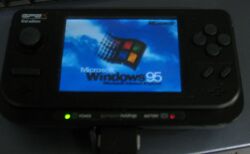 The GP2X is a portable game console that runs Linux and was released in November last year. This is a console that encourages you to hack its open platform and has a dev wiki to document those projects. Mandleman has recently gotten Bochs, the x86 emulator, running on the platform. He then booted Windows 95 (Internet Archive) on top of that; It takes six and a half minutes. He’s also built emulators for the NES, NeoGeo pocket, and Wonderswan. Recently released Linux based devices like the GP2X and the Nokia 770 are interesting because they encourage development. I hope in the future we’ll see an open device that has the market penetration of the PSP.
The GP2X is a portable game console that runs Linux and was released in November last year. This is a console that encourages you to hack its open platform and has a dev wiki to document those projects. Mandleman has recently gotten Bochs, the x86 emulator, running on the platform. He then booted Windows 95 (Internet Archive) on top of that; It takes six and a half minutes. He’s also built emulators for the NES, NeoGeo pocket, and Wonderswan. Recently released Linux based devices like the GP2X and the Nokia 770 are interesting because they encourage development. I hope in the future we’ll see an open device that has the market penetration of the PSP.
[thanks togi]
















